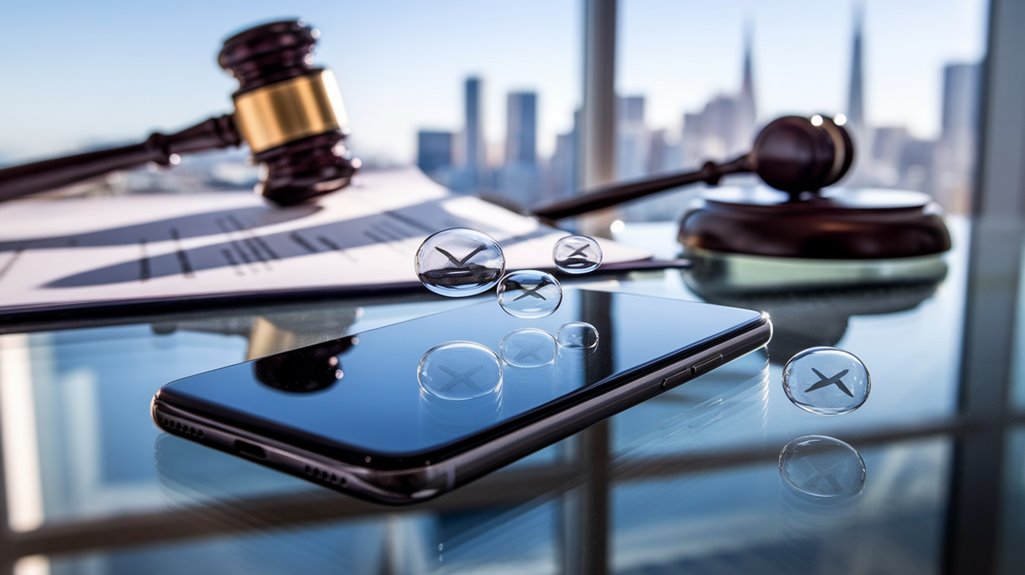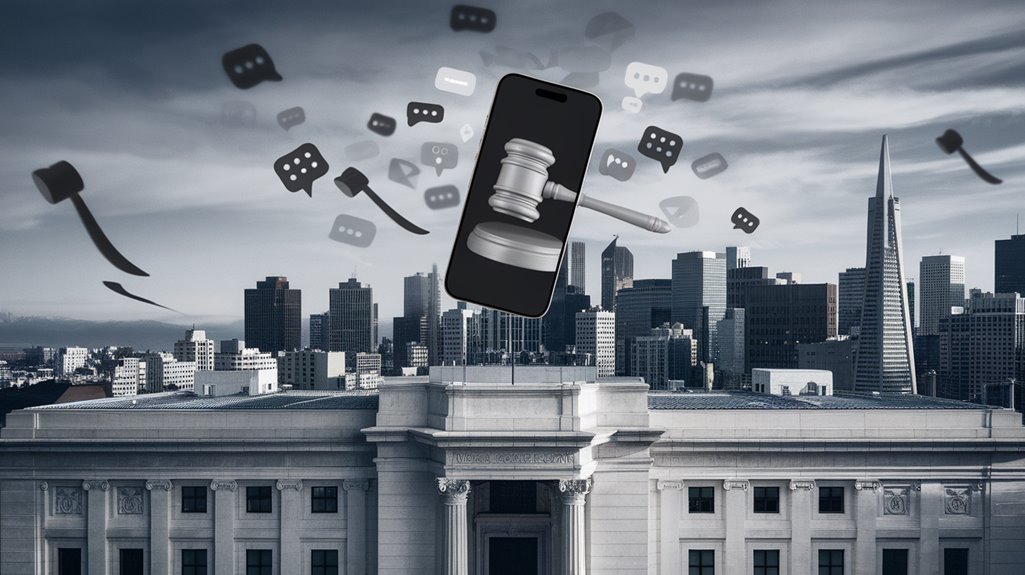Text messages serve as powerful evidence in Bay Area legal cases, but require careful handling. California courts now consider work-related texts as public records, regardless of device ownership. Employers must implement clear retention policies and use automated archiving tools to protect sensitive data. Proper documentation, consent, and forensic collection methods are essential for maintaining evidence integrity. Legal professionals who understand these requirements can better navigate text message compliance and strengthen their defense strategy.
Key Takeaways
- Text messages from personal devices used for work are subject to legal scrutiny and must be preserved under California public records laws.
- Proper documentation and forensic analysis of text messages strengthen their admissibility as evidence in Bay Area courts.
- Implementation of automated archiving systems helps prevent accidental deletion and ensures compliance with retention requirements for legal defense.
- Courts accept properly authenticated text message screenshots with timestamps and metadata as valid evidence in discrimination cases.
- Clear policies regarding text message retention and usage across personal and work devices protect organizations from potential legal liability.
Text Messages as Public Records: What Bay Area Employers Need to Know

How text messages became public records has transformed workplace communication policies across the Bay Area. The California Supreme Court made it clear that content, not device ownership, determines what counts as a public record. This means texts about work are official records, even when sent from personal phones.
Bay Area employers must now focus on text message retention across all devices. They need clear protocols for saving work-related texts and training staff about public record compliance. The rules apply whether messages are sent during work hours or from private devices. Smart employers are using automated tools to archive texts and protect sensitive data. Regular training helps workers understand their responsibilities. Proper management of text messages reduces legal risks and supports transparency in government operations.
Legal Framework for Personal Device Searches in California
California maintains strict legal boundaries around personal device searches under CalECPA. Law enforcement must obtain a warrant to search phones and other electronic devices, even with probable cause. Device owners have clear privacy rights that protect against warrantless searches, though they may voluntarily consent to device inspection under specific circumstances.
Consent Search Legal Boundaries
When conducting searches of personal devices, law enforcement must follow strict consent requirements in California. Any search requires voluntary consent, free from coercion or pressure tactics. Officers must stick to the exact search parameters given by the person. If someone says "search my texts," officers can't look at photos.
| Requirement | What's Needed | Result if Violated |
|---|---|---|
| Consent Type | Voluntary & Express | Evidence Excluded |
| Documentation | Written Form/BWC | Search Invalid |
| Scope Limits | Precise Parameters | Evidence Suppressed |
| Supervision | Manager Approval | Search Unauthorized |
Consent limitations protect privacy rights while allowing necessary law enforcement work. All searches need proper documentation, usually through written forms. In emergencies, body cameras can record consent instead. Breaking these rules means evidence might get thrown out of court.
Device Privacy Rights Framework
Personal device searches in California operate under a complex legal framework. The courts focus on message content rather than device ownership when determining what information must be disclosed. Even texts and emails on private phones are subject to records requests if used for government work.
Privacy expectations shift when personal devices enter the workplace. Employees who use their own phones for business purposes may need to share certain communications during legal proceedings. Companies must create clear policies about device usage and data preservation. They should tell workers about these rules up front.
The law requires strong security measures. This includes unique passwords and limited data collection. Organizations must keep good records to prove they follow the rules during court cases.
Best Practices for Preserving Text Message Evidence

Preserving text message evidence requires careful attention to both policy and technical controls. Companies must implement clear guidelines for employees using personal devices for work communication. Text message authentication starts with proper retention settings and cloud backups.
Digital evidence preservation depends on several key practices. Organizations should issue detailed litigation holds that specifically address text messages. These holds need employee signatures to confirm receipt. Automatic monitoring systems should track any message deletions after holds begin. Companies must also conduct device reviews during exit interviews.
Courts expect businesses to prevent unauthorized deletion of messages. This means having strong policies about saving texts and checking third-party apps. When employees leave, thorough device checks help recover any deleted communications that might be relevant to legal matters.
Privacy Rights vs. Public Disclosure Requirements
The tension between privacy rights and public disclosure creates ongoing challenges in text message litigation. Courts have consistently ruled that text privacy expectations diminish once messages are sent to others. Recipients gain control over sharing, while senders lose protection rights.
Public accountability needs often override individual privacy concerns. Employers can access work-related texts on company devices if their search purpose is legitimate. Courts typically require full text chains rather than selective portions to maintain proper context. Even personal device messages must be preserved when connected to workplace activities.
Authentication remains essential for admissibility. Courts demand proof of authorship through metadata and witness testimony. While encrypted messaging apps create new challenges, the trend favors disclosure over privacy when texts hold significant evidence for legal proceedings.
Mobile Device Forensic Tools in Legal Proceedings

Forensic tools used by law enforcement must follow strict evidence collection protocols to maintain data integrity and chain of custody. Mobile device extractions require proper legal authorization through warrants or consent, with documentation of all handling from seizure through analysis. Privacy concerns arise when agencies use these tools to access deleted content and cloud backups without full disclosure of their capabilities to device owners.
Evidence Collection Best Practices
When legal professionals collect digital evidence from mobile devices, they must follow strict protocols. The first step involves immediately powering down seized devices to prevent data alteration. A detailed chain of custody document tracks every person who handles the device.
Proper data extraction requires forensically sound tools that maintain evidence integrity. These specialized tools allow for forensic analysis while preserving the original content. Law enforcement often uses third-party mobile device forensic tools to bypass encryption and access data.
All evidence must be transported in tamper-evident packaging to prevent physical interference. Screenshots and manual captures are considered less reliable than full device extractions since they can be easily fabricated. Cloud backups and metadata analysis provide additional evidence beyond what's stored on the device itself.
Data Privacy Compliance Issues
As mobile device forensic tools become more sophisticated, privacy concerns have grown considerably. Law enforcement agencies can now bypass device security and extract extensive data, including deleted content and hidden files. This raises serious questions about compliance with privacy regulations and constitutional protections.
Data retention practices by third-party vendors create additional complications. These vendors can access synced information through subpoenas, often circumventing established encryption mandates. Over 90% of forensic tools can decrypt iOS and Android devices without jailbreaking, challenging individual privacy rights.
The widespread use of these tools in consent searches often exceeds traditional search boundaries. This creates tension with post-Carpenter legal precedents and various privacy laws. Courts continue to grapple with balancing law enforcement needs against evolving digital privacy standards.
Workplace Policies for Text Message Management
Modern businesses need clear rules for managing work-related text messages. Text messaging policies must address key compliance requirements, particularly obtaining employee consent before any workplace texting begins. Companies should establish strict guidelines around after-hours communications, limiting texts to genuine emergencies or critical updates.
Organizations must implement robust data retention protocols to meet legal obligations. This includes archiving work-related texts for required periods and ensuring proper encryption of sensitive information. Companies should clearly define whether employees can use personal devices for work texts and specify approved messaging platforms. The policies should also outline prohibited content, such as offensive language or harassment, while establishing formal procedures for handling text-based disputes. These measures help protect both employers and employees while maintaining professional communication standards.
Impact of Encrypted Messaging Apps on Legal Cases

The rising popularity of encrypted messaging apps creates significant challenges for legal proceedings. Apps like Signal and WhatsApp use end-to-end encryption and auto-deletion features, making evidence recovery difficult. These digital evidence challenges affect both civil and criminal cases.
Statistics show encrypted apps now account for 5% of workplace communications, with message retrieval rates 8 times lower than traditional SMS. The encrypted messaging implications are severe, as shown in high-profile cases like Amazon's antitrust suit where deleted conversations hampered investigations. Companies face increased regulatory scrutiny, with SEC fines reaching $81 million for firms using ephemeral apps without proper archiving.
Courts now average $6.2 million daily fines for noncompliance in producing encrypted data, while 77% of companies using these apps fail to maintain required records.
Notable Bay Area Text Message Cases and Outcomes
Several high-profile Bay Area text message cases have shaped legal precedents in Northern California. The San Francisco Police Department’s racist texting scandal revealed how text message analytics exposed misconduct, leading to disciplinary actions and broader corruption investigations. In Antioch, text messages became central to murder cases under the Racial Justice Act, highlighting digital communication ethics in law enforcement. These cases demonstrate text messages’ vital role in both prosecuting misconduct and defending against criminal charges. Furthermore, these incidents underscore the Miranda warning significance in law, as they bring to light the complexities of obtaining confessions and the protection of individual rights in the digital age. The intersection of technology and law raises questions about the admissibility of text messages as evidence, often prompting debates on privacy and civil liberties. As more cases rely on digital communications, the legal system must navigate these challenges to uphold justice while ensuring accountability in law enforcement practices.
Text messages have become powerful legal evidence in Bay Area police misconduct cases, reshaping law enforcement accountability and criminal proceedings. As digital communication continues to proliferate, attorneys are increasingly incorporating these messages into their arguments, revealing patterns of behavior and systemic issues within police departments. This shift has prompted the development of complex litigation strategies in Bay Area, allowing for a more comprehensive examination of potential wrongdoing and reinforcing the necessity for transparency and reform within law enforcement. Moreover, the use of text messages as evidence has also influenced selfdefense claims in bay area courtrooms, as attorneys leverage digital correspondences to challenge the credibility of these assertions. This evolution in legal strategy not only impacts individual cases but also has broader implications for public trust in law enforcement practices. By highlighting inconsistencies and exposing misconduct, the integration of digital evidence is fostering a climate where accountability is not just encouraged, but expected. The implications of this trend are further compounded by the need for a clear understanding of legal protections surrounding digital communications, particularly as they relate to the attorney-client relationship. As cases increasingly involve text messages and other forms of digital evidence, the boundaries of attorney-client privilege are being scrutinized, raising important questions about what constitutes confidential communication. In this context, attorney-client privilege explained becomes crucial for both clients and attorneys to navigate the complexities of digital evidence in legal proceedings, ensuring that the rights of the accused are preserved while promoting the pursuit of justice.
- SFPD texts exposed racist messages, resulting in court-approved disciplinary actions
- Text evidence helped dismiss domestic violence and drug trafficking charges
- Antioch PD case showed impact of officer texts on criminal proceedings
- Court rulings established text messages on personal devices can be public records
Strategies for Responding to Text Message Discovery Requests

Effective management of text message discovery requests requires immediate preservation of relevant communications upon receiving a litigation hold notice. Legal teams must establish clear search protocols that define the scope of responsive messages while protecting private, non-business content. Setting boundaries around privacy concerns helps balance discovery obligations with personal data protection, especially when texts contain mixed business and personal communications.
Preserving Evidence Early
When legal disputes arise involving text messages, organizations must act swiftly to preserve relevant communications. Text retention strategies should begin immediately when litigation seems likely. Companies need clear evidence preservation techniques that cover both company and personal devices used for business.
- Issue detailed legal hold notices that specifically mention text messages across all platforms
- Implement preservation policies for both company-issued and personal devices
- Document the legal right to access business-related texts on employee devices
- Monitor compliance with text message retention requirements
Early preservation helps avoid costly sanctions under Rule 37(e). Courts examine whether organizations took reasonable steps to protect text messages from deletion. Quick action demonstrates good faith and prevents allegations of intentional evidence destruction. Companies should focus on thorough preservation across all communication channels used for business purposes.
Scope of Search Protocol
Developing a clear search protocol helps organizations respond efficiently to text message discovery requests. Organizations must define specific search parameters that balance discovery obligations with privacy considerations. This includes setting appropriate time frames, identifying relevant custodians, and using targeted keywords.
Courts expect parties to establish "good cause" through interrogatories and demonstrate the relevance of requested messages. Organizations can propose phased searches to manage scope and minimize burden. They may also use specialized software to separate work-related from personal content. Time-based filters and keyword targets help narrow searches to specific dates and topics. When facing broad requests, parties can cite proportionality standards under FRCP 26(b)(1) to challenge excessive scope while ensuring adequate preservation of relevant messages.
Privacy Boundary Management
Organizations handling text message discovery requests must master privacy boundary management. Proper text message etiquette and digital communication ethics are essential when maneuvering these sensitive matters. Companies need clear protocols to protect private information while meeting legal obligations. This balance requires systematic approaches to data preservation and careful consideration of privacy rights.
- Implement automated archiving systems that filter personal communications from business-related texts
- Create clear guidelines for employees about text message retention and privacy expectations
- Use forensic tools that respect privacy boundaries while recovering relevant communications
- Establish protocols for handling sensitive personal information found in text messages during discovery
These measures help organizations maintain compliance while respecting individual privacy rights. Regular audits guarantee the effectiveness of these privacy protection measures throughout the discovery process.
Text Evidence in Discrimination and Harassment Claims

Text messages have become essential evidence in discrimination and harassment claims. The digital harassment evidence found in texts can establish hostile work environments, particularly when messages contain unwelcome jokes or comments about protected characteristics. Text message implications extend beyond simple communication, as their digital nature allows retrieval even after deletion.
Courts now readily accept text screenshots with timestamps and metadata as proof in cases. Digital forensics can recreate message chains to show patterns of coercion or escalating threats. This is especially important in cases involving quid pro quo harassment, where texts may contain explicit directives linking job threats to sexual acts. For employers, failing to address text-based harassment through proper training and policies can result in significant liability under employment laws.
Legal Obligations for Text Message Retention
While text messages serve as powerful evidence in discrimination cases, their proper retention has become a major legal concern. Organizations face strict text retention policies under various regulations and legal frameworks. Companies must navigate compliance challenges while preserving business-related texts, including those on personal devices.
Text messages can make or break discrimination lawsuits, yet many organizations struggle to properly preserve these critical digital records.
- Public companies must keep texts for 7 years under SOX Act requirements
- Healthcare and financial sectors have specific retention rules for text communications
- Legal holds require immediate preservation when litigation is anticipated
- Courts can impose hefty fines for deleted messages, up to $1,000 per text
Both metadata and message content need proper preservation. This includes timestamps, sender details, and conversation threads. Companies should implement clear protocols to prevent automatic deletions and guarantee consistent compliance with retention obligations.
Navigating Personal and Business Communication Boundaries

Drawing clear boundaries between personal and business communications helps prevent legal complications. Legal professionals recommend setting both personal boundaries and professional boundaries through specific policies.
A key strategy is establishing clear "off-hours" periods when non-urgent messages can wait until the next business day. This protects mental health and maintains productivity. Communications with clients should stick to business matters only, avoiding personal topics that could blur professional lines.
Using designated business communication platforms keeps work messages separate from personal conversations. This separation prevents mixing of personal and professional data, which could become problematic in legal situations. It also protects privacy by keeping personal communications on separate devices or apps, reducing the risk of accidental disclosure during legal proceedings.
Text Message Compliance in Public Sector Employment
Public sector employees face distinct rules about their text messages at work. Text message retention policies require agencies to preserve communications about public business, even on personal devices. Employee communication guidelines establish strict protocols for handling sensitive information and managing work-related texts.
- Government agencies must use automated archiving systems to comply with legal requirements
- Employees need training on proper archiving methods instead of manual screenshots
- Personal and work devices require clear policies about acceptable text message use
- Text monitoring must balance legal compliance with employee privacy rights
Agencies must follow state-specific retention schedules and respond to FOIA requests. Courts can demand text messages from both work and personal devices during legal proceedings. While monitoring work communications is necessary, agencies should respect privacy boundaries and obtain proper consent when required.
Emerging Trends in Text Message Evidence Collection

Modern courts face growing challenges with text message evidence collection. Text message authentication challenges have pushed legal teams to adopt more sophisticated verification methods. Courts now rely on multiple approaches to confirm message authenticity.
Forensic analysis techniques have become essential tools in evidence gathering. These include metadata preservation, phone number tracking, and drive imaging. Many courts now prefer forensic imaging over manual examination of phones. This method better preserves critical data like timestamps and sender IDs.
The rise of self-destructing messaging apps has complicated collection efforts. Authentication costs can range from $2,500 to $20,000 per case. Machine learning tools help detect fake messages by analyzing format inconsistencies. More courts are requiring unredacted message chains when relevant content exists within conversations.
Frequently Asked Questions
How Long Does a Mobile Device Forensic Examination Typically Take to Complete?
A mobile device forensic examination duration typically ranges from several hours to multiple weeks. The timeline varies based on device complexity, data volume, and security measures. Simple forensic analysis might take 4-8 hours, while complex cases involving encrypted devices or large data sets can extend to 2-3 weeks. Factors like extraction method, procedural requirements, and evidence documentation all impact the total processing time needed to complete the examination.
What Happens if an Employee Refuses to Surrender Their Personal Device?
When employees refuse to surrender personal devices, they face serious legal implications. Courts can issue orders forcing compliance, especially if the device was used for work. Non-compliance may result in adverse inferences against the employee and potential sanctions. While employee rights protect some privacy, unreasonable refusal during investigations can lead to disciplinary action or termination. Employers may also seek court intervention to compel device surrender if business data is involved. In situations where personal devices contain critical business information, the stakes are even higher, as companies strive to protect their assets. Employees may find themselves defending against vehicle theft or other legal issues that arise from non-compliance, emphasizing the importance of cooperation. Ultimately, understanding the legal landscape and the necessity of device surrender in work-related matters can help mitigate risks and foster a more compliant workplace culture.
Can Deleted Text Messages Still Be Recovered After Factory Resetting a Phone?
Text message recovery after a factory reset is possible, but success depends on timing and device usage. Factory resets only mark data for deletion without immediate overwriting. Messages remain recoverable until new data takes up the storage space. Various recovery tools can scan internal storage to retrieve deleted texts. However, data privacy features and device encryption may limit access. Once the storage is overwritten by new apps or updates, recovery becomes impossible.
How Much Do Professional Text Message Recovery Services Usually Cost?
Professional text message recovery service costs typically start between $400-$1,000 for basic cases. Many providers offer free initial evaluations to assess recovery feasibility. Final pricing depends on several factors, including recovery difficulty, data type, and urgency. Services often use tiered pricing based on device type and damage severity. Some companies offer success-based fees, meaning clients only pay if messages are successfully recovered. Emergency or legal-grade services may cost more.
Are Voice Messages and Phone Call Logs Treated Differently Than Text Messages?
Getting to the bottom of it, voice messages and call logs follow different authentication rules than texts. Voice message privacy standards often require expert analysis to verify the speaker's identity. Call log admissibility typically depends on carrier records for verification. Courts generally view voice recordings as more complex evidence since tone and inflection matter. While texts need basic authentication, voice evidence must clear higher hurdles to prove reliability and authenticity.
Conclusion
Text messages have become both a blessing and a curse in Bay Area legal cases. While lawyers gleefully mine digital gold from message threads, employees keep forgetting that "delete" doesn't really mean delete. The irony is rich – the more we try to keep things private, the more public they become. In the end, those little blue bubbles might just be the modern equivalent of writing on bathroom walls.
